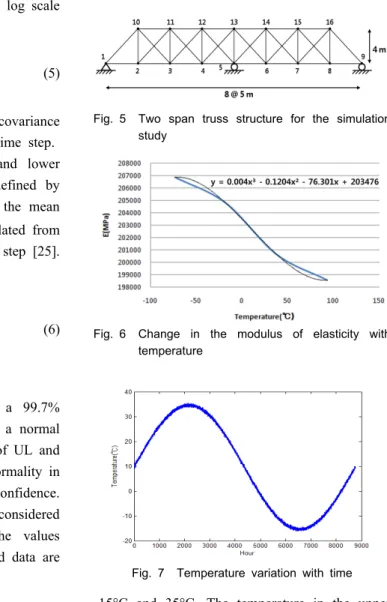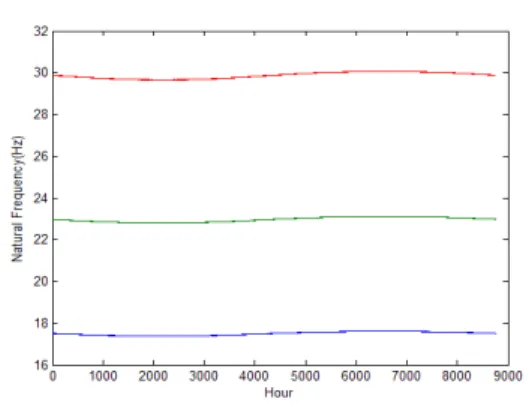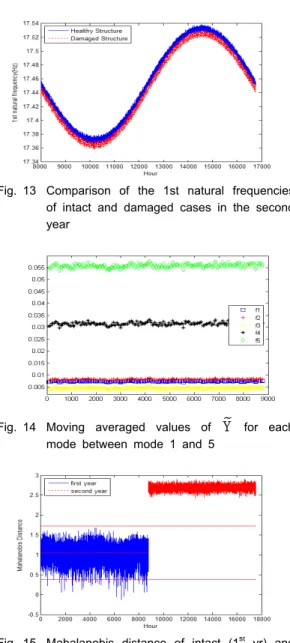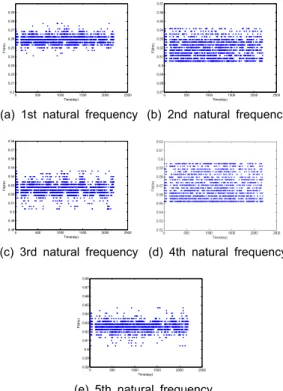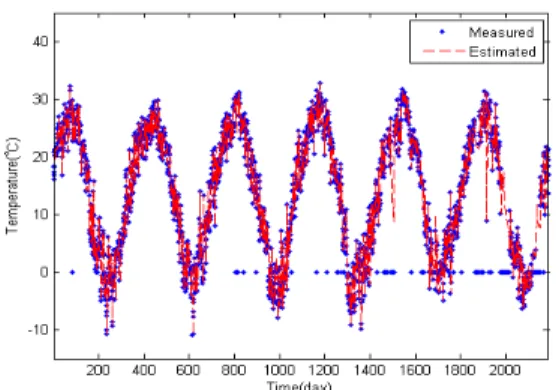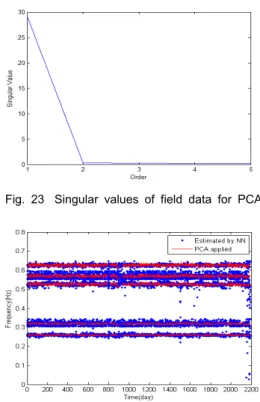Bridge Health Monitoring with Consideration of Environmental Effects
Yuhee Kim*, Hyunsoo Kim*, Soobong Shin*✝ and Jong-Chil Park**
Abstract Reliable response measurements are extremely important for proper bridge health monitoring but incomplete and unreliable data may be acquired due to sensor problems and environmental effects. In the case of a sensor malfunction, parts of the measured data can be missing so that the structural health condition cannot be monitored reliably. This means that the dynamic characteristics of natural frequencies can change as if the structure is damaged due to environmental effects, such as temperature variations. To overcome these problems, this paper proposes a systematic procedure of data analysis to recover missing data and eliminate the environmental effects from the measured data. It also proposes a health index calculated statistically using revised data to evaluate the health condition of a bridge. The proposed method was examined using numerically simulated data with a truss structure and then applied to a set of field data measured from a cable-stayed bridge.
Keywords: Bridge Health Monitoring, Data Analysis, Missing Data, Environmental Effects, Health Index
[Received: October 25, 2012, Revised: December 5, 2012, Accepted: December 10, 2012] *Department of Civil Engineering, Inha University, 100 Inharo, Nam-gu, Incheon 402-751, Korea, **Korea Expressway Co., Kyunggi-do, Korea ✝Corresponding Author: sbshin@inha.ac.kr
ⓒ 2012, Korean Society for Nondestructive Testing
1. Introduction
Large scale infrastructure, such as roads, bridges, dams and tunnels, require to secure structural integrity because they are frequently exposed to hazardous conditions. Since a struc- ture can face unexpectedly severe conditions due to overloaded vehicles, natural disasters, such as typhoons, and environmental actions, it is essen- tial to maintain the structural integrity by monitoring the health condition [1,23]. In partic- ular, it is critical to monitor in a systematic manner the health condition of special structures, such as long span bridges.
Structural health monitoring(SHM) for struc- tural systems has been studied since the 1970s but extensive studies of SHM of bridge structures began only in the early 2000s, as illustrated in Fig. 1 [10]. Fig. 1(a) shows the number of papers published annually in international journals by the end of 2010 searched using the keyword ‘SHM’ only, and Fig. 1(b) the number of reports obtained using
the keywords, ‘SHM’ and ‘bridge’, through the service of LANDSCOPE [10]. Fig. 2 also illustrates the number of papers published annually in international journals for research related to ‘temperature’ problems with the keywords (a) ‘temperature’ and ‘SHM’, (b)
‘temperature’, ‘SHM’ and ‘bridge’, and (c)
‘temperature’ and ‘bridge’. Research into temperature problems in bridge structures has a long history since the 1940s (Fig. 2(c)). On the other hand, research on SHM considering temperature effect has a relatively short history (Fig. 2(a)). In particular, the research on bridge structures started only recently, as shown in Fig.
2(b). Thus Figs. 1 and 2 highlight the need for more research related to SHM for bridge structures considering environmental effects.
The steps for SHM are normally divided as
follows: (1) processing and analyzing the
measured data, (2) diagnosing the structural
health condition, (3) locating structural damage,
and (4) assessing the severity of damage. In
some cases, steps (2) ~ (4) can be reduced to 1
(a) Searched with the keywords of ‘SHM’
(b) Searched with the keywords of ‘SHM’ & ‘bridge’
Fig. 1 Number of papers published in international journals related to ‘SHM’ [10]
(a) Searched with the keywords of ‘SHM’
(b) Searched with the keywords of ‘SHM’ & ‘bridge’
(c) Searched with the keywords of 'temperature' & 'bridge' Fig. 2 Number of papers published in international
journals related to ‘temperature’ [10]
Fig. 3 Schematic view of the current research scope
or 2 steps and then another step of determining the prognosis can be added. The current paper focuses only on steps (1) and (2); setting up the procedure for data analysis and defining a health index to judge any structural abnormality. Since many studies have evaluated data processing, this study presumes that the data provided from field measurements has already been treated by filtering out noise. Under this assumption, this paper narrows the scope down to (1) recovery of missing data, (2) consideration of environmental effects on the measured data, and (3) calculation of a health index to evaluate the global health condition of a particular structure. In each step, an effective method is selected from the methods available in the literature and modified for the current purpose. Fig. 3 shows a schematic diagram of the scope of current research.
A simulation study was carried out on a two-span truss structure to examine the proposed procedure of data analysis and the effectiveness of the health index. The measured data was simulated according to the temperature variations.
The method was then applied to field data measured from an actual cable-stayed bridge open to public transportation on a highway. This paper evaluates and discusses the results obtained.
2. Data Analysis Considering Environmental Effects
2.1 Recovery of Missing Data
Some parts of measured data can be missing
Fig. 4 Measured deformation with missing parts [18]
due to a malfunction of sensors or some other reason, as demonstrated in Fig. 4. In this case, it is essential to first recover the missing parts of the measured data to monitor the structural integrity more reliably.
Several methods have been introduced to estimate such missing data. Sohn [21] derived a linear regression model with the measured temperature variations and natural frequencies, and then applied this model to predict the natural frequencies for the next year using the measured temperature variations. Serker et al.
[20] also used a similar approach using a linear regression model but applied it to measured strain data rather than acceleration data. On the other hand, they also had to derive a regression model with the measured data of the previous year as baseline information. Peeters and Roeck [17] derived an ARX model using the measured temperature variations and natural frequencies up to four low modes, and applied that model to predict the natural frequencies of the next year with the measured temperature variations. Kullaa [8,9] proposed methods for recovering missing or incomplete data using the correlation in-between measured data. This method demonstrated the advantage of its possible applications to various types of measured data.
Nevertheless, it still required a set of baseline information to derive its model.
Another approach using a back-propagation neural network(NN) algorithm was proposed
[26]. Natural frequencies and mode shapes were used as the input neurons, whereas the target data corresponding to the input data were used as the output neurons. The error between the calculated output and target output values were back-propagated through the layers repeatedly to revise the weightings. Since the success of such a NN algorithm is dependent on the quality of training under a range of environments, it is essential to carry out an adequate amount of learning processes before applying the NN model to field data. Ko et al. [6] employed a similar approach for the Ting Kau Bridge in Hong Kong. They trained a NN model using the measured temperature variations and natural frequencies obtained for a one year period. Ni et al. [16] also employed a NN model for a bridge, measuring the same types of data, temperature variation and natural frequencies.
They used the data measured for 770 hours as the baseline information to train their NN model with all four layers including the input, output and hidden layers.
Since previous studies demonstrated that a bridge structure normally shows a good correlation between the natural frequencies and temperature variation, it is clear that a conspicuous pattern between them might be recognized easily by a NN approach. Therefore, this study employed the concept of a NN approach to recover missing data.
2.2 Elimination of Environmental Effects
The effects of environmental actions on the
structural dynamic behaviors have been studied
widely in SHM because structural dynamic
characteristics, such as natural frequencies and
mode shapes, are influenced more by environ-
mental conditions, such as temperature variation,
as shown in Fig. 2. Some studies on bridge
structures indicated that temperature variations
might be the most influential environmental
parameter [11,15,21,24]. A range of studies concluded that the health condition can be monitored more reliably using revised data by eliminating the environmental effects from the measured data [3,26].
A range of methods have been introduced in the literature to eliminate the environmental effects from the measured data. Conventional approaches include regression analysis [17], novelty detection [12], missing data analysis [8,9], singular value decomposition [19,22], and a support vector machine [15]. Another approach evaluating the environmental effects statistically with measured signals only without using an analytical model includes principal component analysis(PCA) [25], factor analysis [5,7] and neural network(NN) [6]. Since a signal-based approach is more feasible in field applications, this paper adopted the PCA method and modified it to the current research purpose by eliminating the environmental effects from the measured data.
The main idea of the PCA method is to reduce a matrix of natural frequencies,
Y × , with n modes and N samples to a matrix,
X × , with only m principal components by multiplying a loading matrix
T × , as expressed in Eq. (1) [25].
X T Y
(1)
where X is a linearly projected matrix onto a domain ℜ
mfrom a domain ℜ
nof
Ywhere
.
If m principal components can be selected by considering environmental effects on the natural frequencies, the matrix
Xcan be considered to contain only the environmental aspects in the natural frequencies. The loading matrix
Tcan be obtained by selecting m eigenvectors ordered by the larger values of a covariance matrix or by selecting m larger singular values. The current approach employed a singular value decomposition to calculate the
principal components using Eq. (2).
Y YT U
UT(2)
where
Uis an orthogonal matrix and is
a diagonal matrix containing singular values.
The loading matrix
Tconsists of the components from the 1
stto the m
throw vectors ordered by larger singular values.
Since the projected matrix
Xcontains an environmental aspect only, the error information can be obtained by subtracting
Xfrom
Y. On the other hand, the domain size ℜ
mof
Xis generally different from the domain size ℜ
nof the original matrix
Y. Therefore, it is essential to back-project
Xto
Yenvin the original domain ℜ
nusing Eq. (3) and then to calculate the error by eliminating
Yenvfrom
Y, as expressed in Eq. (4).
Yenv TTX TTT Y
(3)
Y Y Yenv
(4)
2.3 Calculation of the Health Index
The global structural health condition can be evaluated using the error matrix
Yof Eq. (4).
In the current approach, the structural health condition is evaluated by comparing the current condition to the baseline information of a presumably intact condition. Local damage detection and assessment are out of the scope of the current research because natural frequencies are used as the major measured information from a bridge.
As one of the useful health indices, the
Mahalanobis norm has been used in some cases
[3,25]. On the other hand, it has been observed
that this index frequently oscillates severely out
of the bounds, particularly when there is severe
noise in the measured data. Therefore, this study
proposes a modified distance MD on the log
Fig. 5 Two span truss structure for the simulation study
Fig. 6 Change in the modulus of elasticity with temperature
Fig. 7 Temperature variation with time
scale defined by Eq. (5) by applying a log scale to the original formulation.
(5)
where
R
Y YTis the covariance matrix of the matrix
Yand k is the time step.
The center line CL, the upper and lower limit lines of UL and LL, can be defined by Eq. (6) using the statistical values of the mean
and standard deviation
calculated from the Mahalanobis distances at each time step [25].
(6)
If
= 3 is used in Eq. (6), a 99.7%
confidence level can be guaranteed in a normal distribution. Therefore, the limit lines of UL and LL can be used to determine any abnormality in the structural integrity with 99.7% confidence.
In other words, the structure can be considered to be in a healthy condition if the values calculated using a new set of measured data are within these limit boundaries.
3. Examination through Simulation Studies
3.1 Analytical Model for the Simulation Study
To examine the proposed procedure of data analysis and the health index of eqns. (5) and (6), a simulation study was carried out with a two-span truss structure, as shown in Fig. 5.
The area of each member was assumed to be 0.0025 m
2and the mass density was 7,850 kg/m
3. For the simulation study, the modulus of elasticity was assumed to vary with temperature, as shown in Fig. 6 [2]. Fig. 7 shows the annual variation of the daily mean temperature between
-15°C and 35°C. The temperature in the upper and lower chord members was simulated to be 5°C higher and lower, respectively, than that of the diagonal and vertical members. To simulate the measured temperature, a 1% random varia- tion in the modulus of elasticity was added arbitrarily to each member.
3.2 Simulation of Measured Data
Based on the information in Figs. 6 and 7,
the natural frequencies up to ten low modes
were calculated. Fig. 8 presents the variations of
the first three with time for one year. All 8,760
sampling data points for each mode were
Fig. 8 Change in natural frequencies with time
Fig. 9 Variation of the first natural frequency with time
(a) Whole range of the second year
(b) Hour: 10,801~11,100 (c) Hour: 15,301~15,600 Fig. 10 Prediction of the first natural frequencies in
the second year
obtained by calculating the natural frequencies once an hour for one year.
A NN model was defined using the measured natural frequencies of ten modes and the simulated temperature variation. The temperature variation of each member in time was considered as input values. The corre- sponding natural frequencies were the output values in the NN model. The number of neurons in the hidden layers was selected to minimize the estimation error. The tangent sigmoid function and linear function were used as transfer functions in the model.
The NN model was trained by the data for the first year and then used to predict the natural frequencies of the second year at various temperatures, as shown in Fig. 9 for the first natural frequency. In this paper, a NN model was defined for each mode separately. For the current simulation study, 35 neurons in one input layer, 40-60-20 neurons in the hidden layers, and 1 neuron in the output layer were selected.
Fig. 10(a) compares the simulated real data and the data of the first natural frequencies in the second year estimated from the trained NN model. Figs. 10(b) and 10(c) compare those two data regions in detail around the minimum and maximum values of the first natural frequencies inside the circles drawn in Fig. 10(a). Although those two regions had relatively higher error in the estimated results, the model trained with the first year data predicted the variation of the first natural frequencies quite reasonably.
3.3 Elimination of Environmental Effects
As shown in Fig. 10, the first natural
frequency varied with temperature and time. The
PCA method was applied to eliminate such
environmental action on the measured data. The
singular values of the measured data were
calculated (Fig. 11). Since ten low modes were
Fig. 13 Comparison of the 1st natural frequencies of intact and damaged cases in the second year
Fig. 14 Moving averaged values of Y for each mode between mode 1 and 5
Fig. 15 Mahalanobis distance of intact (1st yr) and damaged structure (2nd yr)
Fig. 11 Computed singular values for PCA
Fig. 12 Computed health index with a NN model trained with the first year data
measured from the simulated truss structure, the dimension n for the original modal information matrix
Yequaled 10. On the other hand, because only one singular value was clearly higher than the others, the dimension m for the projected domain of
Xequaled 1. In other words, temperature is the only influential environmental factor that should be eliminated from the data.
3.4 Calculation of Health Index
The log-scaled Mahalanobis distance was calculated using Eq. (5), and the CL, UL, and LL lines are drawn by Eq. (6) in Fig. 12. In Fig. 12, the first year data was used to train the NN model and to estimate the second year data.
The trained model could predict a healthy condition in the entire range of interest with some minor outliers below the lower limit line LL.
To confirm the utility of the health index, a damage case was simulated with reduced axial stiffness of the member in the upper chord
between nodes 14 and 15 in Fig. 5. For the simulation study, a 2% decrease in axial stiffness was assumed. Fig. 13 compares the change in the first natural frequencies of the intact and damaged cases in the second year.
The first natural frequencies of the damaged cases were slightly lower than those of the intact cases. The moving averages of the error
Y
of Eq. (4) are drawn in Fig. 14 for each
mode between modes 1 and 5. The figure shows
that the error due to damage is larger for a
0 500 1000 1500 2000 2500 0.2
0.21 0.22 0.23 0.24 0.25 0.26 0.27 0.28 0.29
Time(day)
F1(Hz)
0 500 1000 1500 2000 2500
0.27 0.28 0.29 0.3 0.31 0.32 0.33 0.34 0.35 0.36 0.37
Time(day)
F2(Hz)
(a) 1st natural frequency (b) 2nd natural frequency
0 500 1000 1500 2000 2500
0.48 0.49 0.5 0.51 0.52 0.53 0.54 0.55 0.56 0.57 0.58
Time(day)
F3(Hz)
(c) 3rd natural frequency (d) 4th natural frequency
0 500 1000 1500 2000 2500
0.58 0.59 0.6 0.61 0.62 0.63 0.64 0.65 0.66 0.67 0.68
Time(day)
F5(Hz)
(e) 5th natural frequency
Fig. 18 Variation of natural frequencies measured from a cable-stayed bridge for six years Fig. 16 View of the test bridge
□ accelerometer Fig. 17 Sensor layout for the maintenance of the
bridge
higher mode in general, even if all the error values are quite small.
Using the computed error
Yafter elimi- nating the temperature effect, the Mahalanobis distances of Eq. (5) were calculated for the damaged case with the data of the second year and then compared with those of the first year (Fig. 15). The figure confirms that the health index used in the present study could clearly identify the health condition, even when only one truss member was damaged by a 2%
decrease in axial stiffness.
4. Application to Field Data
The field data measured from a cable-stayed bridge shown in Fig. 16 were used to confirm the usefulness of the proposed approach. The bridge is located in a highway crossing a sea channel. The total length of the cable-stayed bridge part is 990 m (60+200+470+200+60 m).
Various types of sensors were installed to measure the bridge behavior and environmental actions, as shown in Fig. 17. Among them, the
data measured from the temperature sensors and accelerometers were used in the present study.
4.1 Data Processing of the Measured Data
The natural frequencies measured from a cable-stayed bridge for six years, as shown in Fig. 18, were used to confirm the effectiveness of the proposed procedure. Fig. 19 shows the temperature variation between -10°C and 35°C measured from one of the six temperature sensors installed in the bridge during the same period. All the data was provided by the authority in charge of maintaining the bridge.
Each data point of natural frequency and
temperature was obtained by averaging one hour
of data measured every 10 minutes. The data
shown in Figs. 18 and 19 was drawn after
erasing some outlier data far from the general
trend. Since the measurement system was
installed more than 10 years earlier, the sampl-
ing rate was not detailed enough to give a
Fig. 19 Temperature variation during the measuring period
-15 -10 -5 0 5 10 15 20 25 30
0.254 0.256 0.258 0.26 0.262 0.264 0.266 0.268 0.27 0.272
TemTeTaTTTe(℃)
F1(Hz)
Fig. 20 Correlation between the first natural fre- quency and temperature (R=0.714)
Fig. 21 Comparison of the measured and estimated temperature variation by a NN model
Fig. 22 Comparison of measured and estimated natural frequencies by a NN model
satisfactory outcome. Nevertheless, the variations of the first, third, and fifth natural frequencies in Fig. 18 showed sinusoidal patterns that might correlate with the temperature variation in Fig.
19. On the other hand, it was difficult to observe any vivid pattern in the measured even modes, possibly due to the triggering process on the raw data carried out by the maintenance authority. Fig. 20 shows the correlation between the first natural frequency and temperature; their computed correlation factor was 0.714. This suggests that the two data measurements correlated well but not linearly.
4.2 Data Analysis and Prediction
Before developing a NN model between the measured temperatures and natural frequencies, the missing parts in the temperature variation
were first estimated by applying another NN model. Fig. 21 shows the estimated temperature variation with the filled missing parts by the NN model compared to the original measured data in Fig. 19.
A NN model was then trained for each
mode using the first two-year measured data of
natural frequencies and temperature. Each NN
model was defined with five layers including 1
input layer with 7 neurons, three hidden layers
with 25-40-7 neurons, and 1 output layer with 1
neuron. The input data for the NN model of the
temperature variations comprised the temper-
atures measured at the lower parts of the
girders, crossbeams and the upper parts of the
girders in the bridge. Fig. 22 compares the
measured and estimated natural frequencies by
the trained NN model for six years. The overall
variations show a reasonalble match, as demon-
Fig. 23 Singular values of field data for PCA
Fig. 24 Comparison of estimated natural frequencies Y by the NN model and its Ye n v
0 200 400 600 800 1000 1200 1400 1600 1800 2000 -5
-4 -3 -2 -1 0 1 2 3 4
5 PCA Model : SVD
Time(day)
Mahalanobis DisTance
baseline moniToTed
(a) Mahalanobis distance defined by Eq. (5)
0 200 400 600 800 1000 1200 1400 1600 1800 2000 -1
0 1 2 3 4 5 6 7
8 PCA Model : SVD
Time(day)
Mahalanobis DisTance
baseline moniToTed
(b) Mahalanobis distance without log scale Fig. 25 Heath index of field data
![Fig. 1 Number of papers published in international journals related to ‘SHM’ [10]](https://thumb-ap.123doks.com/thumbv2/123dokinfo/4746587.514763/2.808.87.381.64.1041/fig-number-papers-published-international-journals-related-shm.webp)
![Fig. 4 Measured deformation with missing parts [18]](https://thumb-ap.123doks.com/thumbv2/123dokinfo/4746587.514763/3.808.95.382.820.1003/fig-measured-deformation-with-missing-parts.webp)
